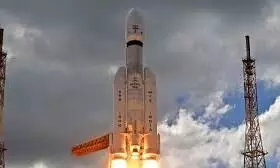
Chandrayaan-3 successfully completes final lunar orbital adjustment, aims for historic moon landing
text_fieldsBengaluru: India's Moon mission, Chandrayaan-3, is progressing towards its historic attempt to land on the lunar surface.
The Indian Space Research Organisation (ISRO) announced the successful completion of the second and final de-boosting operation for Chandrayaan-3. This crucial manoeuvre took place this morning as scientists closely monitored the spacecraft's trajectory, bringing it one step closer to its planned soft landing on the Moon's unexplored south polar region, scheduled for Wednesday.
The lander, named Vikram, has positioned itself in an orbit with its closest point to the Moon at 25 km and the farthest at 134 km.
It is from this orbit that Vikram will undertake its soft landing. ISRO shared the update on social media, stating, "The second and final deboosting operation has successfully reduced the LM orbit to 25 km x 134 km. The module would undergo internal checks and await sunrise at the designated landing site. The powered descent is expected to commence on August 23, 2023, around 1745 Hrs. IST."
Vikram has been autonomously executing its descent in the Moon's orbit, independently determining its operational procedures. ISRO's former chief, K Sivan, highlighted that the lander's design for Chandrayaan-3 remains consistent with that of the earlier Chandrayaan-2 mission. "There is no change in design. Based on observations from Chandrayaan-2, all errors that took place in the mission have been corrected," he said.
A successful landing on the Moon would mark India as the fourth country in history to achieve this significant milestone.
On Thursday, the lander module separated from the propulsion module that had transported it from Earth. The propulsion module will continue to orbit Earth for an extended period, focusing on studying the planet's atmosphere and analysing the polarisation of light from clouds.
Following the detachment, the lander shared its initial images of the Moon, setting the stage for its upcoming tasks. Once situated on the lunar surface, Vikram will capture images of the Pragyaan rover, which is designed to study the Moon's surface chemical composition and search for water. The rover has a lifespan equivalent to one lunar day, equivalent to 14 days on Earth.
Chandrayaan-3 was launched on July 14 using the LVM3 rocket from the Satish Dhawan Space Centre in Sriharikota. It entered lunar orbit on August 5, advancing steadily towards its ambitious goal.
Meanwhile, in parallel, Russia's Luna-25 probe, which aims to land on the Moon's south pole, encountered an "emergency" situation during a manoeuvre prior to its scheduled landing. The incident has prompted the Russian space agency Roscosmos to evaluate its impact on the mission timeline.
























